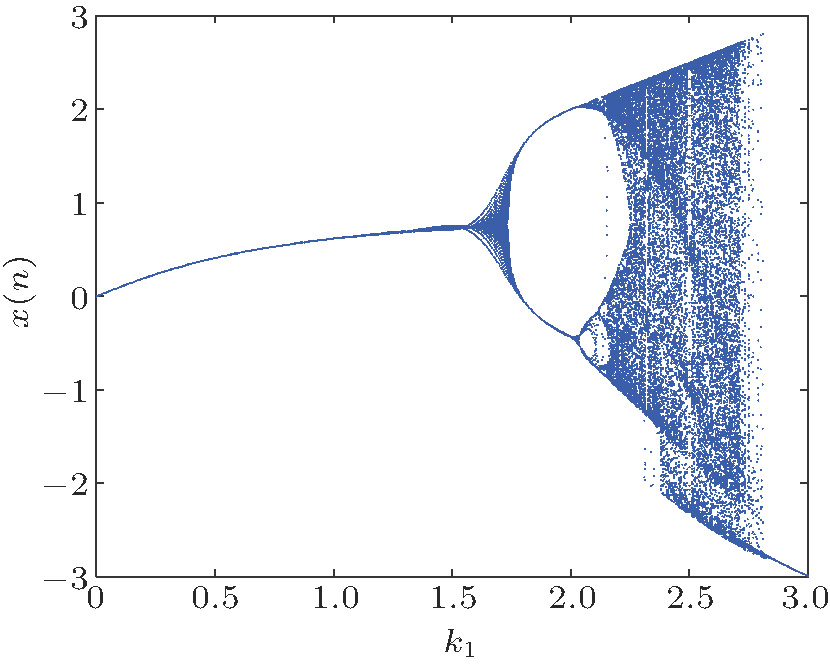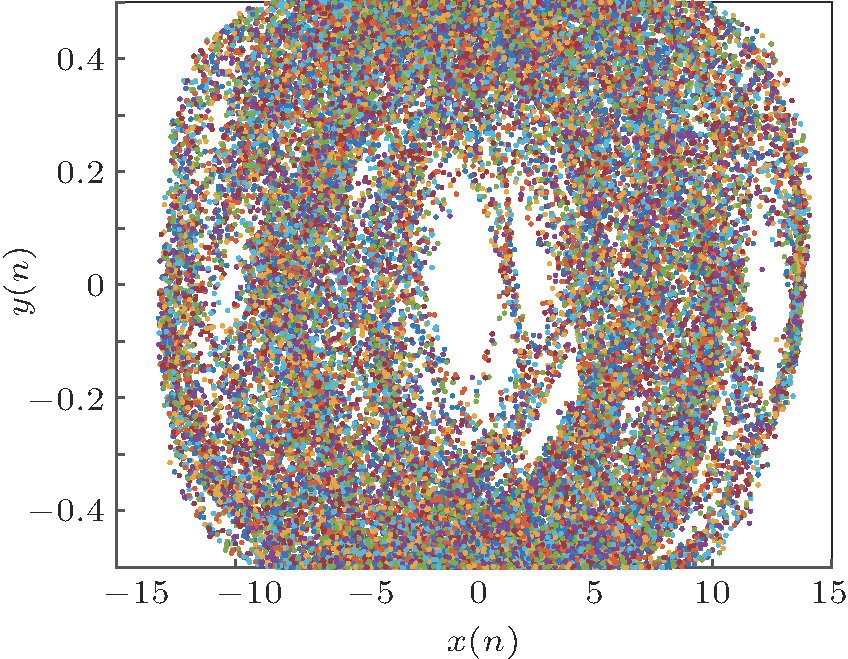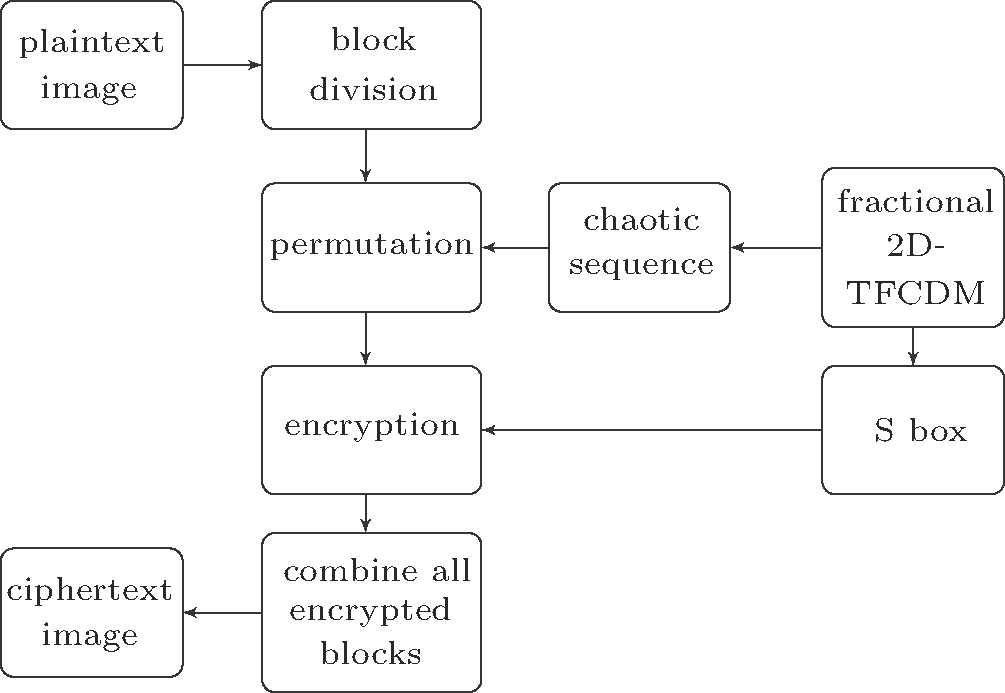† Corresponding author. E-mail:
We propose a new fractional two-dimensional triangle function combination discrete chaotic map (2D-TFCDM) with the discrete fractional difference. Moreover, the chaos behaviors of the proposed map are observed and the bifurcation diagrams, the largest Lyapunov exponent plot, and the phase portraits are derived, respectively. Finally, with the secret keys generated by Menezes–Vanstone elliptic curve cryptosystem, we apply the discrete fractional map into color image encryption. After that, the image encryption algorithm is analyzed in four aspects and the result indicates that the proposed algorithm is more superior than the other algorithms.
Accompanied with the studying of discrete dynamic behavior, its applications have attracted a great deal of attention in secure communication field and a lot of work has been done in recent years.[1–9] For example, Li and Chen[10] have found that the fractional-order Chen system behaves chaotically. The hyperchaotic Lorenz system and Lorenz system have been modified into fractional order one[11,12] and applied in image encryption based on their fractional-order chaotic behavior. Compared with the fruitful results of image encryption utilizing the chaos of continuous fractional calculus, few works have referred to the discrete fractional calculus (DFC) and its applications.
The fractional difference was studied theoretically by Miller and Ross in 1989 as a groundbreaking work,[13] and the fractional integral was given as a fractional integral summation. After that, the theory of the fractional difference equations on time scales was developed.[14] For example, Atici and Eloe focused on the initial value problem,[15] Atici and Senguel referred to the discrete calculus of variations,[16] Holm proposed the Laplace transform[17] and Ortigueira et al. studied signal processing based on the discrete-time derivatives.[18,19] In recent years, Wu et al.[20–22] contributed on the applications of the discrete fractional calculus on an arbitrary time scale, theories of delta difference equations were used to reveal the discrete chaos behavior.
Elliptic curve cryptography (ECC) is an increasingly popular method for securing data and communication via public key encryption. ECC[23,24] has some advantages such as less computing, small storage capacity, and narrow bandwidth. Many public-key algorithms, such as Diflle–Hellman, EIGamal, and Schnorr, can be implemented in elliptic curves over finite fields. While sub-exponential algorithms can solve the integer factorization problem, only exponential algorithms are known for the elliptic curve discrete logarithm problem (ECDLP), so the ECC can achieve the same level of security with smaller key sizes and higher computational efficiency.[25] The Menezes–Vanstone elliptic curve cryptosystem (MVECC) is one of the famous elliptic curve public-key cryptosystems.[26]
Inspired by the work of the discrete dynamics behaviors,[27,28] one of the main goals is to introduce applications of the discrete fractional calculus on an arbitrary time scale[15,16,29] and to expose the discrete chaos behaviors of the fractionalized chaotic map by taking advantage of the theories of delta difference equations.
With the rapid development of transmitting images on the internet and information hiding, information security has attracted a great deal of attention in recent years. Image encryption is one of the widely used methods to protect image information, which can be implemented in optics and has become a more and more popular research area, nowadays. Many encryption methods within fractional derivatives have been proposed in recent years, such as the fractional-order hyperchaotic Lorenz system,[11] fractional-order Lorenz systems,[12,30] fractional-order Chen chaotic system,[31] synchronization of fractional chaotic systems[32] and delayed fractional-order chaotic logistic system.[33]
In Refs. [34]–[36], a new image encryption method based on fractional chaotic time series within the fractional-order difference was proposed, while the two-dimensional chaotic map within the fractional-order difference has seldom been proposed in color image encryption. It is well known that one-dimensional chaotic maps have the advantages of simplicity and high efficiency.[37] While the proposed two-dimensional fractional-order chaotic map can be converted into a more robust algorithm in image encryption due to more parameters being added in the equations.
The main purpose of this paper is to introduce a new discrete two-dimensional fractional-order map and detect its chaos behaviour. In addition, we apply the map into the color image encryption and decryption with the keys enciphered by MVECC. This paper has eight sections: the definitions and the properties of the DFC are introduced in section
Let us briefly recall the fractional calculus definitions firstly. The definitions of the fractional sum and difference are given as follows. Within the DFC, the function f(t) is changed as a sequence f(n). Let 




Let P = (x, y), then the negative of the point P is 
If points 

The scalar multiplication is defined as
MVECC is a cryptosystem that uses the elliptic curves for “masking”, the plaintexts and ciphertexts are allowed to be arbitrary pairs of (nonzero) elements (i.e., they are not required to be points on 
If user A wants to encrypt and send message M to user B, then they go through the following steps:
1) User A and user B make an agreement on an elliptic curve 
2) User B selects a private key k firstly and generates a public key γ = kα (
3) When user A wants to send a message 

4) The ciphertext 



Any adversary who only knows β and γ without the private keys d and k will find tht it is very difficult to solve the ECDLP to get the plaintext x. What is more, if # E has only one big prime divisor, the EC is called a secure EC.[40] Hence, MVECC is an efficient and secure technique.
From the fractional calculus,[20–22] we notice the application of the DFC to fractional generalizations of the discrete chaotic maps. In a recent paper,[42] the following 2D-TFCDM was introduced:
An explicit numerical formula of equation (
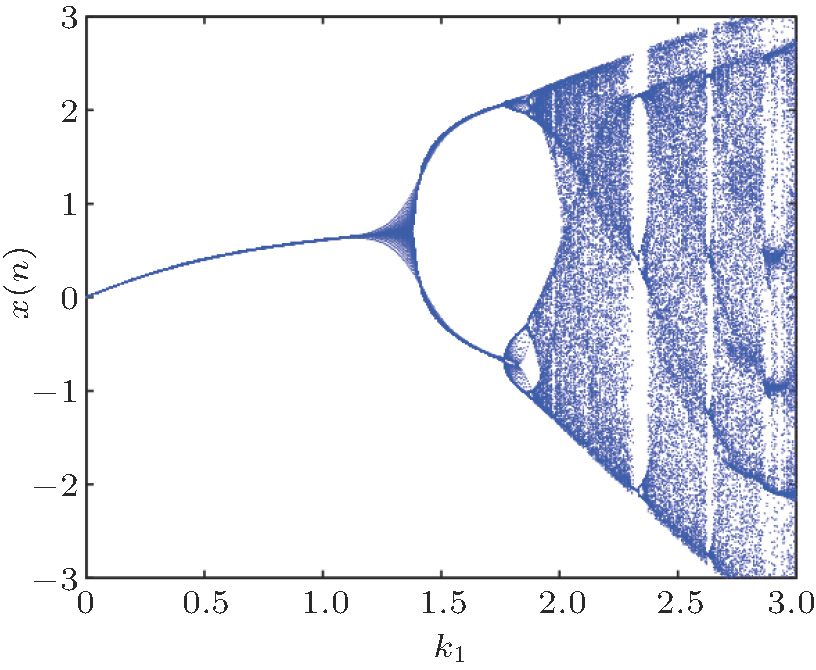 | Fig. 2. (color online) The bifurcation diagram of the fractional 2D-TFCDM of variable k1 for ν = 0.8. |
 | Fig. 4. (color online) The largest Lyapunov exponent of the fractional 2D-TFCDM of variable k1 for ν = 0.8. |
We choose 201 different initial values and derive the phase portraits of the integer map in Fig.
The fractionalized chaotic map can also be applied in information security fields. Exploit Eq. (
Suppose that E is an elliptic curve defined over F100363 with parameters a = 1,b = 6 in Eq. (















By using Eq. (




The procedure of permutation can be subdivided into the following four steps:
1) Set x0 equal to x(1), do an iteration operation for 

2) Reorder x(k) by the bubble sort to get 
3) Change the M × N original picture V into 1 × MN sequence v(k), reorder v(k) the same as x(k) according to z(k) then get 
4) Change 


By reversing this process, we can decrypt 
1) Do all permutation steps in Section 



2) Set i = 0.
3) Retain only the integer part of 


4) Consider the following formula:


5) Compute the number k according to
6) Change 


The decryption procedure has two parts as follows:
I) Do the same step in the encryption process until the step 4) is changed into Eq. (
II) Reverse the procedure in section
Figure
 | Fig. 10. (color online) Pine. (a) The original figure, (b) the encrypted figure, and (c) the decrypted figure. |
 | Fig. 11. (color online) Lena. (a) The original figure, (b) the encrypted figure, and (c) the decrypted figure. |
 | Fig. 12. (color online) Yacht. (a) The original figure, (b) the encrypted figure, and (c) the decrypted figure. |
 | Fig. 13. (color online) House. (a) The original figure, (b) the encrypted figure, and (c) the decrypted figure. |
 | Fig. 14. (color online) Cornfield. (a) The original figure, (b) the encrypted figure, and (c) the decrypted figure. |
 | Fig. 15. (color online) Tiffany. (a) The original figure, (b) the encrypted figure, and (c) the decrypted figure. |
 | Fig. 16. (color online) Ground. (a) The original figure, (b) the encrypted figure, and (c) the decrypted figure. |
 | Fig. 17. (color online) Island. (a) The original figure, (b) the encrypted figure, and (c) the decrypted figure. |
In the process of encryption and decryption of Section
In the algorithm proposed in this paper, the initial values x0, y0, the order ν, and the coefficients of chaotic system k1, k2 can be used as the secret keys, so there are five secret keys. Assume that the precision of x0 and y0 is 2 × 10−17 and 3 × 10−17, respectively. Similarly, the secret keys 

The statistical property is significant to an encrypted image, a good encryption method should be robust against any statistical attack.
In an ordinary image, the correlation coefficient of adjacent pixels is usually high for the reason that the adjacent pixels values are close. A good encryption algorithm should make the correlation of adjacent pixels nearly equal to zero. The closer to zero the correlation coefficients are, the better the encryption algorithm is. The correlation coefficients are calculated according to
 | Fig. 18. (color online) Analysis of the correlations of Pine (x direction). (a) Plain image (x direction); (b) encrypted image (x direction). |
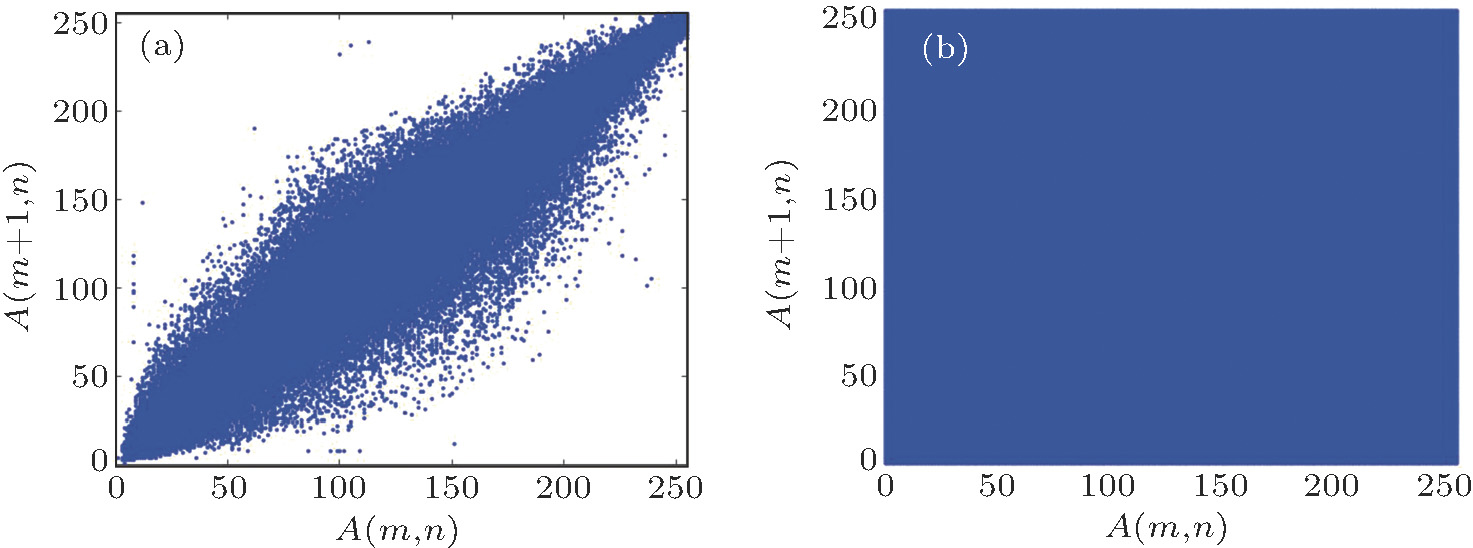 | Fig. 19. (color online) Analysis of the correlations of Lena (x-direction). (a) Plain image (x direction); (b) encrypted image (x direction). |
 | Fig. 20. (color online) Analysis of the correlations of Yacht (x direction). (a) Plain image (x direction); (b) encrypted image (x direction). |
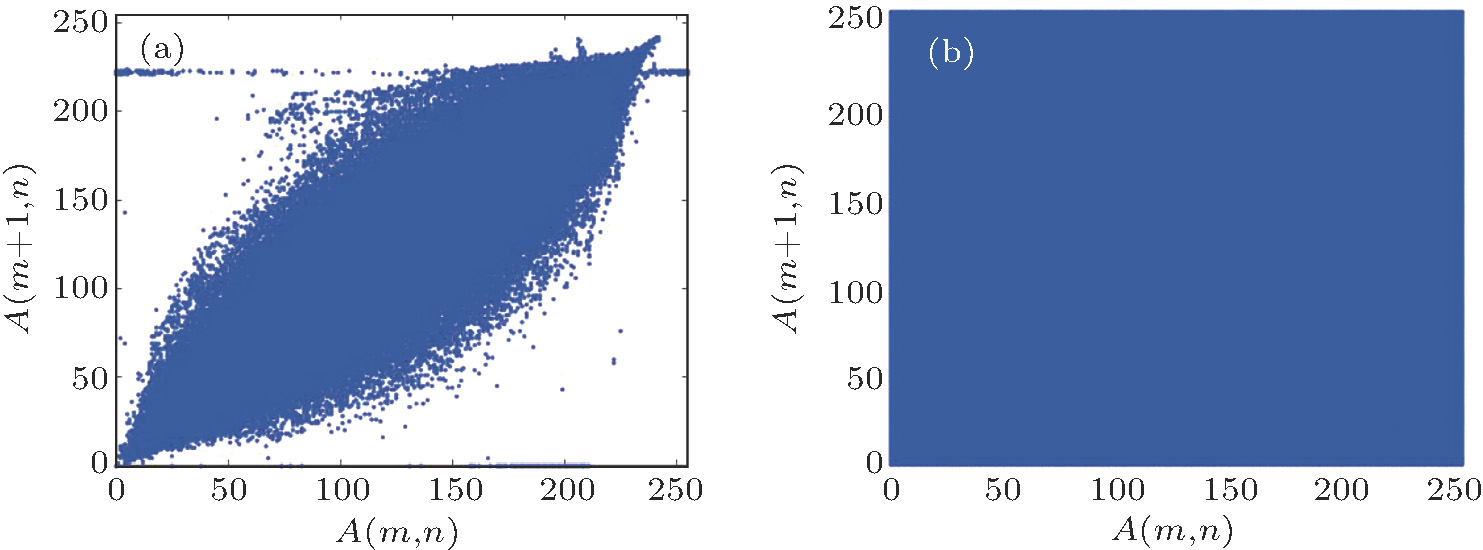 | Fig. 21. (color online) Analysis of the correlations of House (x direction). (a) Plain image (x direction); (b) encrypted image (x direction). |
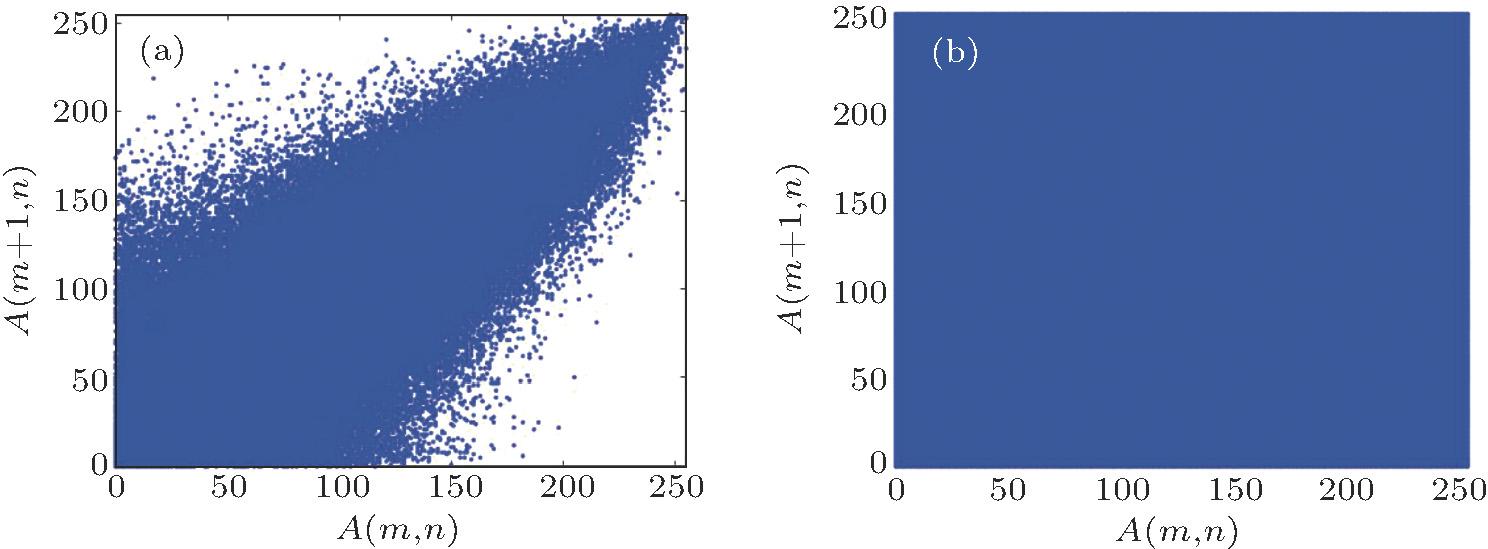 | Fig. 22. (color online) Analysis of the correlations of Cornfield (x direction). (a) Plain image (x direction); (b) encrypted image (x direction). |
 | Fig. 23. (color online) Analysis of the correlations of Tiffany (x direction). (a) Plain image (x direction); (b) encrypted image (x direction). |
 | Fig. 24. (color online) Analysis of the correlations of Ground (x direction). (a) Plain image (x direction); (b) encrypted image (x direction). |
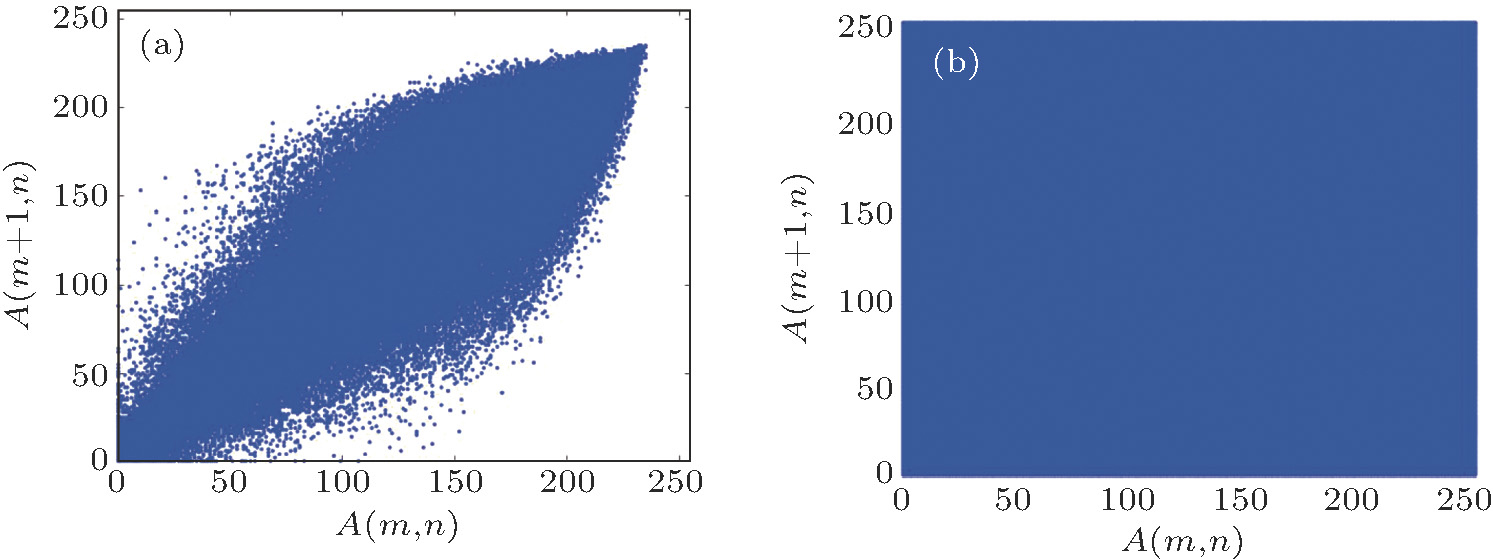 | Fig. 25. (color online) Analysis of the correlations of Island (x direction). (a) Plain image (x direction); (b) encrypted image (x direction). |
| Table 1.
Correlation coefficients of image. . |
Obviously, the correlation of the original image has a linear relationship, however, the encrypted image is stochastic. We can find in Table
From Table
| Table 2.
Comparison of correlation coefficients of image. . |
The distribution of colors inside the image is shown by a histogram. The adversary can obtain some effective information from the regular histogram. Therefore, an encrypted image should be uniformly distributed in an image encryption method with good encryption effect. Figure
 | Fig. 26. (color online) The histogram of Pine. (a) The original figure, (b) the encrypted figure, and (c) the decrypted figure. |
 | Fig. 27. (color online) The histogram of Lena. (a) The original figure, (b) the encrypted figure, and (c) the decrypted figure. |
 | Fig. 28. (color online) The histogram of Yacht. (a) The original figure, (b) the encrypted figure, and (c) the decrypted figure. |
 | Fig. 29. (color online) The histogram of House. (a) The original figure, (b) the encrypted figure, and (c) the decrypted figure. |
 | Fig. 30. (color online) The histogram of Cornfield. (a) The original figure, (b) the encrypted figure, and (c) the decrypted figure. |
 | Fig. 31. (color online) The histogram of Tiffany. (a) The original figure, (b) the encrypted figure, and (c) the decrypted figure. |
 | Fig. 32. (color online) The histogram of Ground. (a) The original figure, (b) the encrypted figure, and (c) the decrypted figure. |
Entropy is a measure of unpredictability of information content. The information entropy is the most important feature of randomness and can be used to measure the degree of uncertainty of a system. It is defined as

| Table 3.
Information entropy. . |
In Table
| Table 4.
Comparison of information entropy. . |
The different range between two images can be measured by two criteria: number of pixels change rate (NPCR) and unified average changing intensity (UACI). They are defined as
We encrypt the image by using the keys x0 = 0.19, y0 = 0.06, ν = 0.7123456, k1 = 8, and k2 = 0.5. Figure 


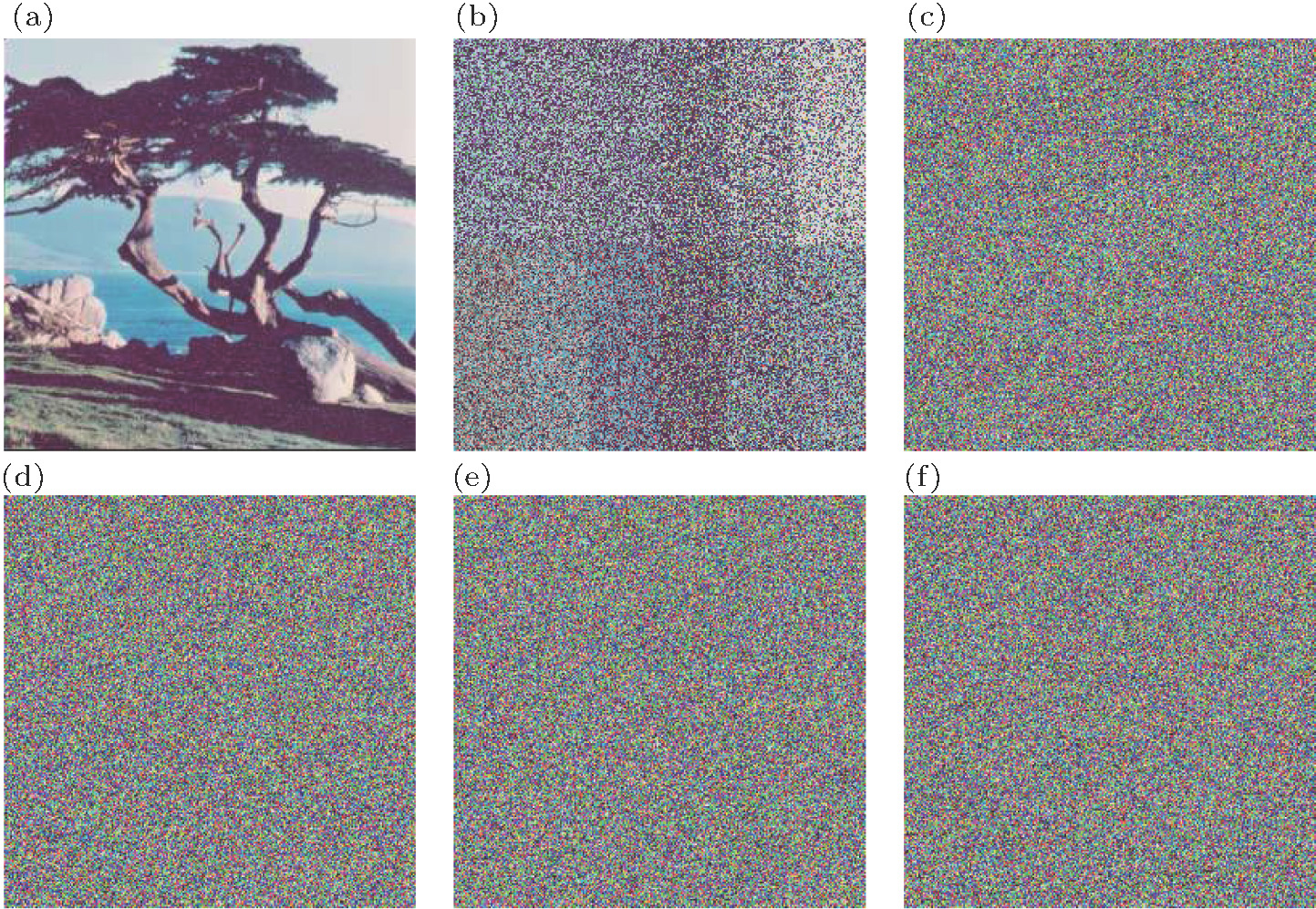 | Fig. 34. (color online) The test of key sensitivity. (a) The normally recovered image, (b) 




|
| Table 5.
Comparison of key spaces. . |
| Table 6.
NPCR and UACI between Figs. |
In contrast with other algorithms, the key space of the proposed algorithm is larger.
It can be observed from Table
By encrypting two original images with one pixel difference and comparing the two encrypted images, the attackers can obtain effective information. A good encryption method should ensure that the two encrypted images are completely different even if there is only one pixel difference.
The results are shown in Tables
| Table 7.
NPCR and UACI between cipher-images with slightly different plain-images (Pine). . |
| Table 8.
NPCR and UACI between cipher-images with slightly different plain-images (Lena). . |
| Table 9.
NPCR and UACI between cipher-images with slightly different plain-images (Yacht). . |
| Table 10.
NPCR and UACI between cipher-images with slightly different plain-images (House). . |
| Table 11.
NPCR and UACI between cipher-images with slightly different plain-images (Cornfield). . |
| Table 12.
NPCR and UACI between cipher-images with slightly different plain-images (Tiffany). . |
| Table 13.
NPCR and UACI between cipher-images with slightly different plain-images (Ground). . |
| Table 14.
NPCR and UACI between cipher-images with slightly different plain-images (Island). . |
The ideal values of NPCR and UACI are 99.61% and 33.46%, respectively.[43] From Table
| Table 15.
Comparison of NPCR and UACI. . |
In section
In this paper, the fractional 2D-TFCDM was obtained from the 2D-TFCDM and new chaotic dynamics behaviors with the proposed map were found. We also found that the map can be applied in color image encryption and decryption. Finally, the encryption algorithm was analyzed in four aspects. The proposed algorithm is superior to others in almost all aspects.
| [1] | |
| [2] | |
| [3] | |
| [4] | |
| [5] | |
| [6] | |
| [7] | |
| [8] | |
| [9] | |
| [10] | |
| [11] | |
| [12] | |
| [13] | |
| [14] | |
| [15] | |
| [16] | |
| [17] | |
| [18] | |
| [19] | |
| [20] | |
| [21] | |
| [22] | |
| [23] | |
| [24] | |
| [25] | |
| [26] | |
| [27] | |
| [28] | |
| [29] | |
| [30] | |
| [31] | |
| [32] | |
| [33] | |
| [34] | |
| [35] | |
| [36] | |
| [37] | |
| [38] | |
| [39] | |
| [40] | |
| [41] | |
| [42] | |
| [43] | |
| [44] | |
| [45] | |
| [46] |


